
- We now have a Referral Program to read the Splendid Edition of Synthetic Work for free. Potentially.
- The World Economic Forum published its Future of Jobs Report 2023.
- IBM CEO says “I could easily see 7,800 jobs replaced by AI and automation over a five-year period.”
- Chegg Inc. share price crashed from $17.60 (close) to $8.80 (low) after the CEO said that ChatGPT is having an impact on their new customer growth rate during the earnings call.
- The CEO of TurnItIn says that thanks to AI, in 18 months, he will only need 20% of the few hundred engineers he’s employing now. And that he’ll hire them from high school.
- Yuval Noah Harari told The Telegraph that our economic system sees millions of people as completely useless.
- The godfather of artificial intelligence, Geoffrey Hinton, resigned from a post at Google he held for more than a decade so that he could openly talk about the risks of AI without damaging the company.
- New academic research shows that patients prefer the interaction with ChatGPT to the one with doctors.
- Bing AI can be used to hide our inadequacy on Twitter, LinkedIn, and any other online community.
P.s.: This week’s Splendid Edition of Synthetic Work is titled Personalized Ads and Personalized Tutors.
It covers what Khan Academy, UC San Diego Health, UW Health, WPP, VentureBeat, and King (the maker of Candy Crush are using AI for. It also reviews the new GrammarlyGO, and shows you how to use the step-by-step prompting technique.
Almost three months in, Synthetic Work starts to take shape.
The Free Edition of the newsletter, the one you are reading right now, continues to focus on tracking how AI is impacting the job market and the way we work, and what it means for you.
As I said from day one, the Free Edition is not about regurgitating the news, but connecting the dots scattered across news, academic research, charts, surveys, social sentiment analysis online and offline, and everything in between.
By the way, connecting the dots, for me, also means experimenting with all the technologies we mention here, so that we actually have a clue of what we are talking about (a rare quality these days). I spend endless nights using every AI tool I can get my hands on just to understand how it feels to use it, and to try and put myself in the shoes of those who will use these tools for the first time.
When you start aggregating and curating the data collected from all these information channels, a deeper picture emerges, and that’s what I hope will inform all of you about what’s happening and what’s the best course of action to react.
As you will read below, the evidence that AI impacting the job market is multiplying and, with it, the attention on Synthetic Work.
There are multiple CEOs, Chief Human Resources Officers, and other top executives from large companies among the readers of this newsletter. There are also teachers, photographers, sales managers, marketing interns, occupational psychologists…you name it.
We are all coming together with a growing sense of urgency that what’s happening deserves our attention more than anything else we’ve seen in the past.
The Splendid Edition of the newsletter is, hopefully, helping you to be prepared for what you read in the Free Edition:
- At a company level, it tracks who’s actually using AI among your industry peers and competitors, to understand who’s pulling ahead and if AI actually works for this or that use case (it’s often all lies, you know?).I cannot emphasise enough how critical this information is for those companies that are still trying to figure out if it’s time to test AI solutions or wait more time.
- At a personal level, it provides the knowledge you need to interact better with AI by, for example, suggesting how to improve your prompts or what are best tools/products/services for a certain business task thanks to AI superpowers.
To further help on these fronts, I’m creating a number of tools that organize the information that I shared so far via the newsletter and beyond.
Two weeks ago, I announced the upcoming Best AI-Centric Tool for X database. (it’s not out yet, and that name will change).
One week ago, I activated the AI Adoption Tracker that shows you what organizations in what industries are using what type of AI (from what technology provider) for what use case.
Today, I activated the How to Prompt database. It’s a database of techniques to write better prompts that can be used with a variety of AI tools, like Bing, ChatGPT, GPT-4, Dall-E, Midjourney, or Stable Diffusion.
When is the last time you visited the Synthetic Work website? Go take a look. These tools are now grouped in a new tab on the homepage titled “Tools to Learn AI”.
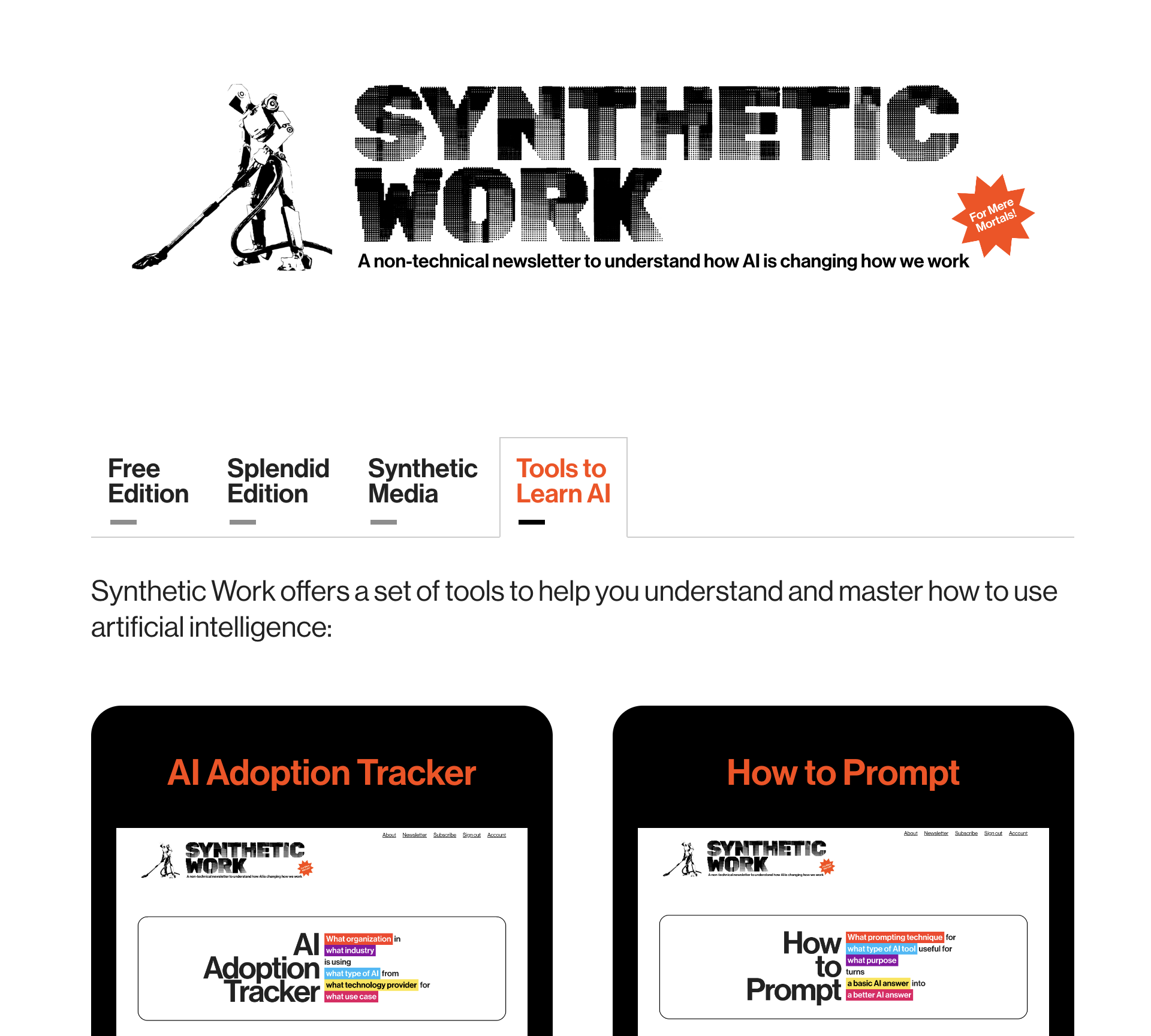
I am considering the idea of creating a What to Prompt tool, as well. Some of you have written candidly admitting: “I know that ChatGPT can do a lot of things, but when I go there I can’t help but stare at the blank page and I don’t really know what to do with it.”
And this is despite an ocean of infographics inundating social media networks about tips and tricks on how to use AI. Perhaps because many examples shared on social media have no real use in the business world or are not specific to our profession?
Can we do a better job here? If so, how?
If you think that What to Prompt might be useful, reply to this email with some feedback or ideas.
Other than these tools, there are another 700 things that I’d like to do, and this week, finally, OpenAI gave me access to the GPT-4 API, so those 700 things might happen.
We’ll see if I’ll get to chance to build Synthetic Work in the way I originally envisioned, and if it’s useful to all of you as I originally hoped.
Want to read the Splendid Edition for free?
More and more people have expressed the desire to read the Splendid Edition and access these new tools I’m building.
I understand that not everybody can afford the price of the memberships that give you access to both, but research is phenomenally expensive and Synthetic Work won’t be a sustainable project without paid memberships.
To help out, I created a Referral Program. Here’s how it works:
Go to your Memberful account panel and then to the Referrals section.
If you don’t remember the URL, it’s:
https://syntheticwork.memberful.com/account/referrals/rewards
Copy your unique URL. If you can convince other people (real people, not AI people, please) to sign up for the newsletter (even the Free Edition) with that URL, you get one of the three discounts available.
If you manage to convince 10 people, you get 100% off next month.
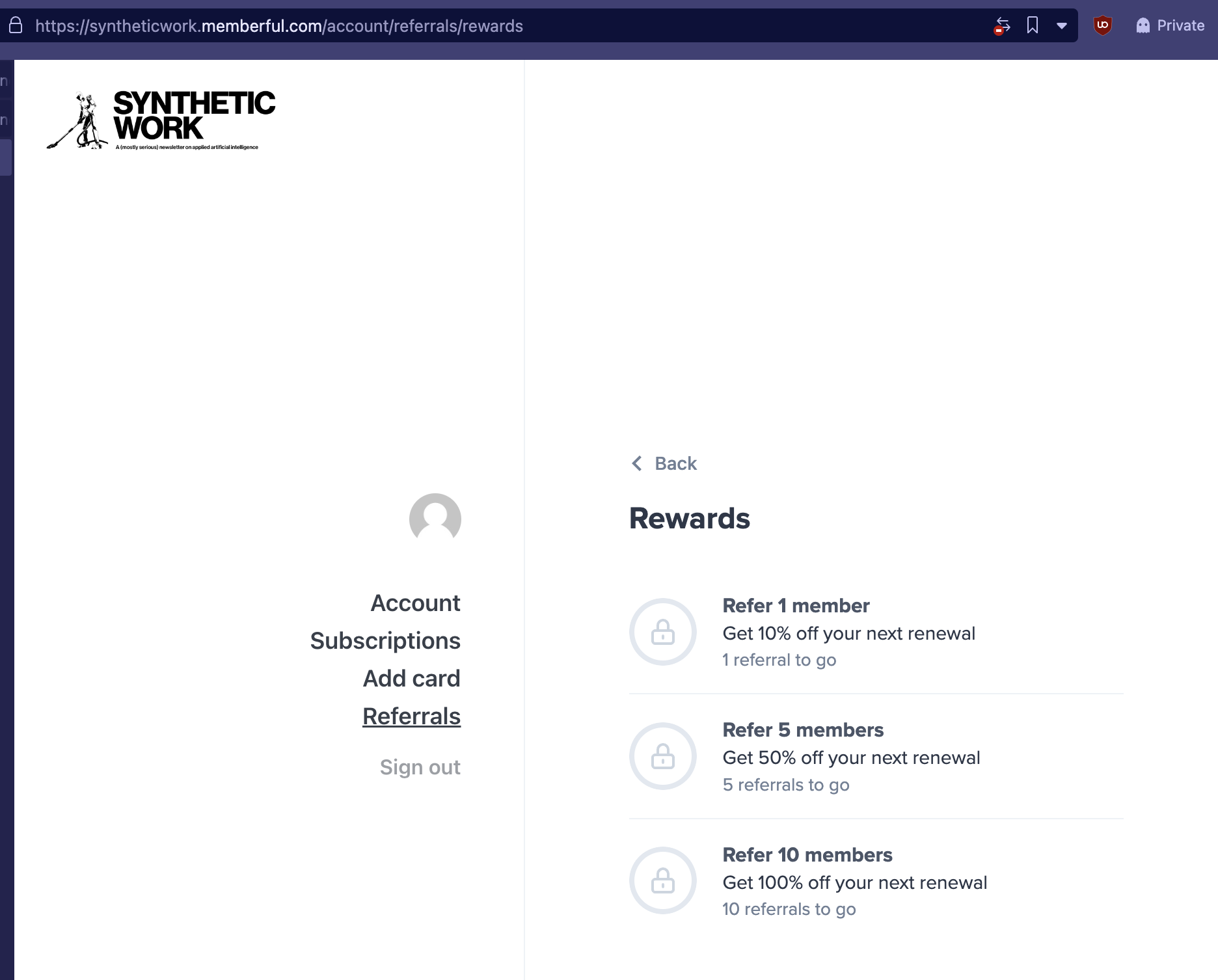
The system keeps track of how many people you have invited have subscribed and discounts your next bill automatically.
It’s not super-intuitive but it’s the best that Memberful allows me to do.
Now. Was this excruciatingly boring to read or what?
Alessandro
Boy, this a week to remember. Here’s six reasons why. They all connect to each other, and it’s more important than usual that they are read all together, as pieces of a single puzzle.
Reason #1: The World Economic Forum published the results of its Future of Jobs Report 2023.
The report is just 296 pages longs. Go and read it, I’ll wait.
Just joking. Nobody would spend so much time on a PDF when they instead could be on Snapchat.
Before I start, a word of caution: in the past, I’ve seen questionable and factually incorrect content published by the WEF. In fact, they allow a number of third parties to publish their opinions under the WEF brand and, of course, because of the brand gravity, people tend to assume that those opinions are facts.
Hopefully, this report was compiled following a more rigorous methodology.
Now, what does it say? The press announcement does the job for us:
The Future of Jobs Report 2023 suggests that almost a quarter of jobs (23%) are expected to change in the next five years through growth of 10.2% and decline of 12.3%. According to the estimates of the 803 companies surveyed for the report, employers anticipate 69 million new jobs to be created and 83 million eliminated among the 673 million jobs corresponding to the dataset, a net decrease of 14 million jobs, or 2% of current employment.
…
The fastest growing roles are being driven by technology and digitalization.Big data ranks at the top among technologies seen to create jobs, with 65% of survey respondents expecting job growth in related roles. The employment of data analysts and scientists, big data specialists, AI machine learning specialists and cybersecurity professionals is expected to grow on average by 30% by 2027. Training workers to utilize AI and big data will be prioritized by 42% of surveyed companies in the next five years, ranking behind analytical thinking (48%) and creative thinking (43%) in importance.
See that “Training workers to utilize AI and big data will be prioritized by 42% of surveyed companies in the next five years“? That’s precisely the reason why I am creating the tools I mentioned in the intro.
There are a lot of similarities between the chart below, about what types of jobs will be created and displaced (not necessarily related to AI), and the many charts we’ve seen from the studies on the impact of ChatGPT on white-collar jobs that we have reviewed in Issue #4 – A lot of decapitations would have been avoided if Louis XVI had AI and Issue #5 – You are not going to use 19 years of Gmail conversations to create an AI clone of my personality, are you?
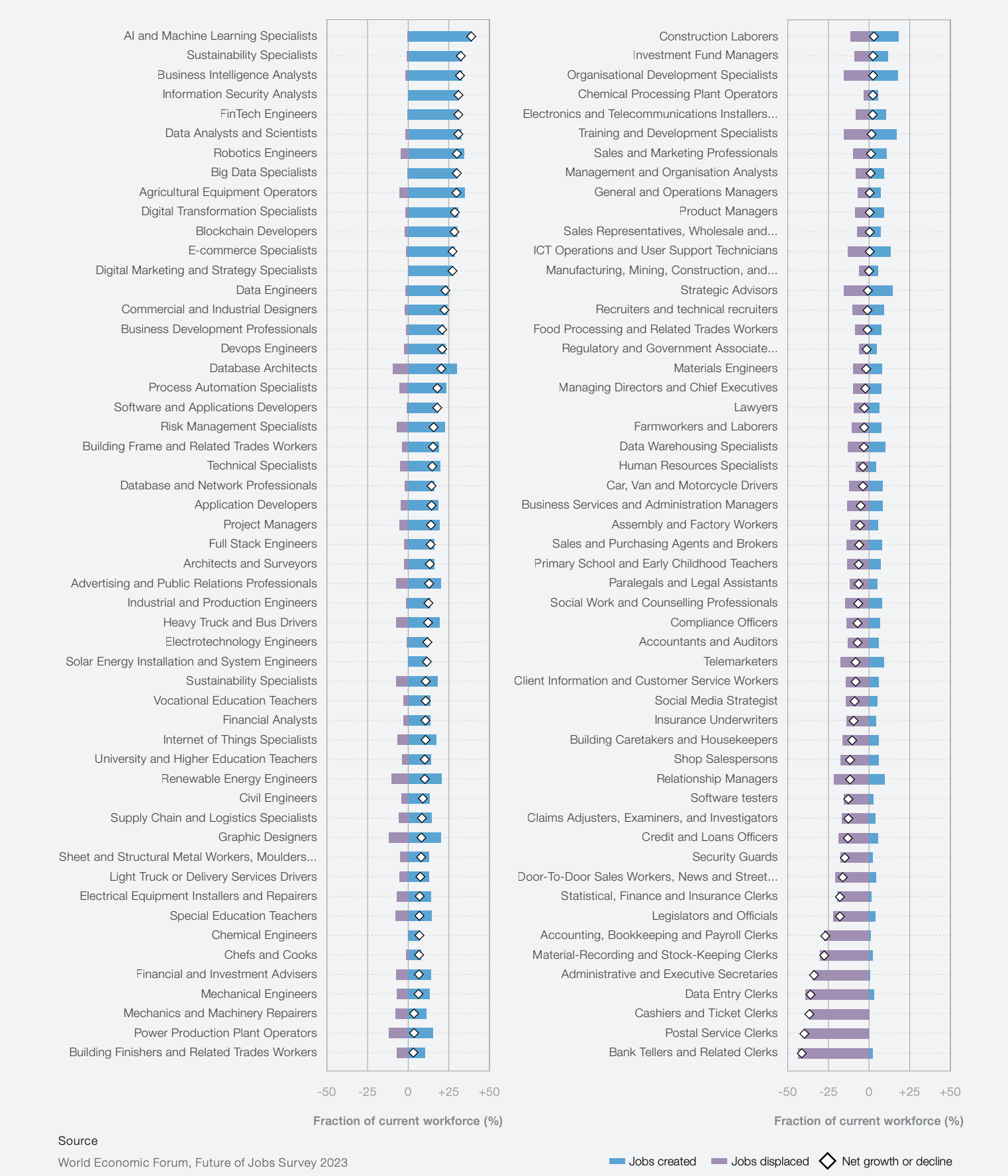
I’m thinking about printing it and taking it out during dinners with friends. It will be fun to see how doomed each of our professions supposedly is.
Yes, I often dine alone.
Let’s continue:
The Future of Jobs Report 2023 suggests that tasks are seen as no more automated now than they were three years ago when the report was last published. About a third of tasks (34%) are currently automated, just 1% above the 2020 figure. Surveyed companies also revised down their expectations for further automation, to 42% of tasks by 2027, compared to 2020 estimates of 47% of tasks by 2025.
But while expectations of the displacement of physical and manual work by machines has decreased, reasoning, communicating and coordinating – all traits with a comparative advantage for humans – are expected to be more automatable in the future. Artificial intelligence, a key driver of potential algorithmic displacement, is expected to be adopted by nearly 75% of surveyed companies and is expected to lead to high churn – with 50% of organizations expecting it to create job growth and 25% expecting it to create job losses.
…
Companies report that skills gaps and an inability to attract talent are the key barriers to transformation, showing a clear need for training and reskilling across industries. Six in 10 workers will require training before 2027 but only half of employees are seen to have access to adequate training opportunities today. At the same time, the report estimates that, on average, 44% of an individual worker’s skills will need to be updated.
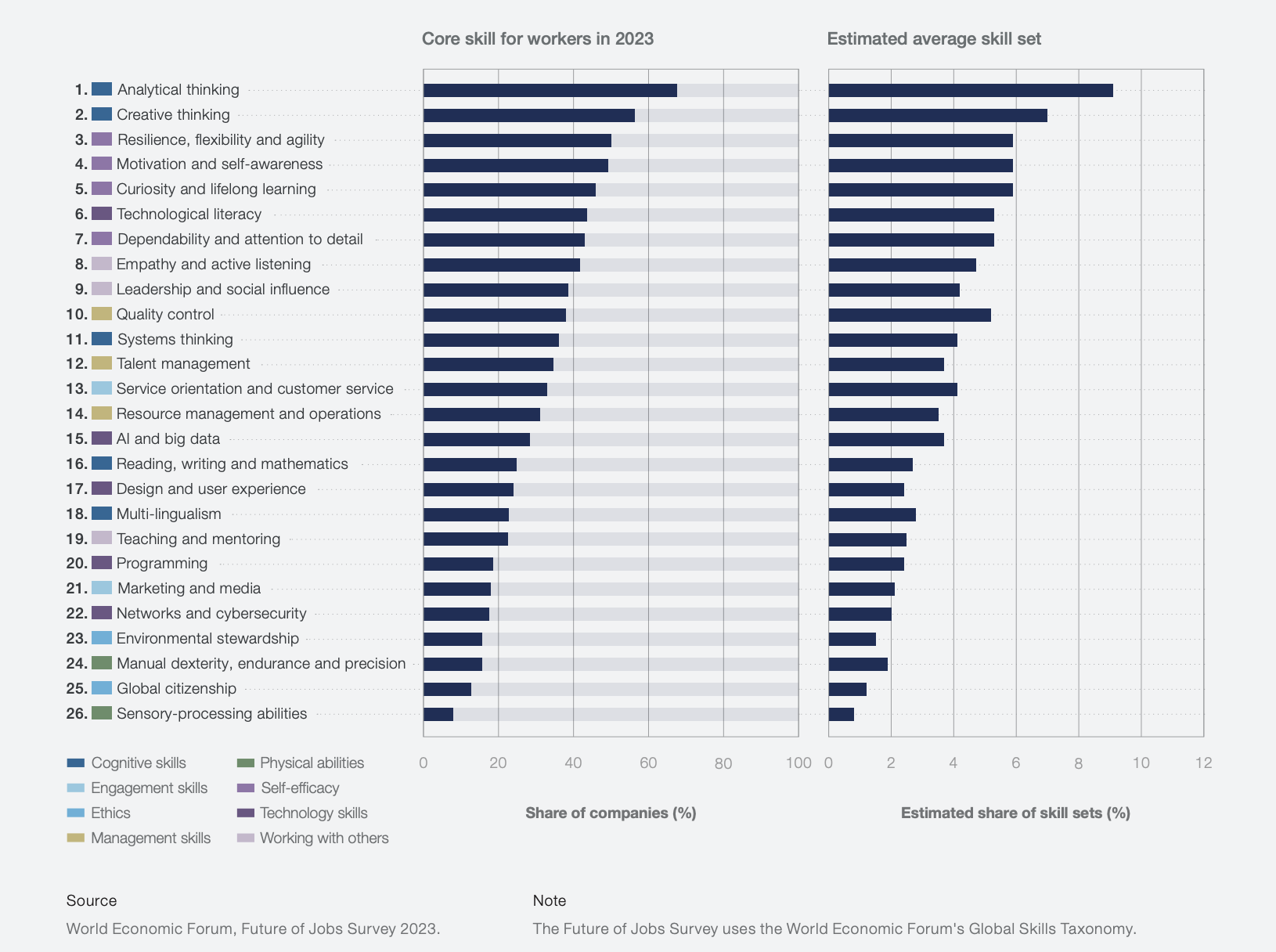
Again, the need for reskilling, and more specifically #6 in this chart (from page 38), is the reason why I’m creating the tools mentioned in the intro.
I’m doubtful about the others as there’s a gap as large as the Milky Way between this list and the requirements you find in job postings.
As much as I’d love for it to happen, I have yet to see a job position that prioritizes analytical thinking and creative thinking over five years of experience on a two-year-old technology.
The risk, as always in this type of research, is that the WEF analysts have inferred conclusions based on the current trends rather than actual facts.
Nonetheless. This survey you must keep in mind as context for what follows below. It’s critical.
–
Reason #2: IBM CEO says “I could easily see 7,800 jobs replaced by AI and automation over a five-year period.”
Brody Ford, writing for Bloomberg, is the messenger of this reassuring statement:
Hiring in back-office functions — such as human resources — will be suspended or slowed, Krishna said in an interview. These non-customer-facing roles amount to roughly 26,000 workers, Krishna said. “I could easily see 30% of that getting replaced by AI and automation over a five-year period.”
That would mean roughly 7,800 jobs lost. Part of any reduction would include not replacing roles vacated by attrition, an IBM spokesperson said.
…
More mundane tasks such as providing employment verification letters or moving employees between departments will likely be fully automated, Krishna said. Some HR functions, such as evaluating workforce composition and productivity, probably won’t be replaced over the next decade, he added.
This message might sound pleasing to some investors who think that the company is going to be more efficient. But the most likely way this will be interpreted by the employees that still have a job is: “The adverse economic conditions gave us the perfect excuse to try generative AI and see if it can do a better job than many of you. If this works, you are going to be next. Good day.”
No sane person would remain at the company like nothing has happened and, if job market conditions allow, people will try to leave before they get replaced. The ones that remain will surely be distracted by this sword of Damocles. And that doesn’t improve productivity through competitive pressure (against AI). It only creates anxiety and destroyed loyalty to the company.
Moreover, a statement like “Some HR functions, such as evaluating workforce composition and productivity, probably won’t be replaced over the next decade.” almost certainly doesn’t take into account the progress that AI will make in a decade, as it’s not foreseeable.
As a reminder, this is the progress that Midjourney, a very popular text-to-image AI model, has done in 12 months:

(and MidJourney 5.1 has been announced 2 days after I wrote this)
The notion that we can confidently say what jobs AI will be able to replace in ten years is laughable.
In the meanwhile, IBM competitors are probably thinking that to stay competitive, they should at least consider doing the same thing. And so, as we said many times on Synthetic Work, a domino effect is triggered and one by one all companies in a given sector start experimenting with AI replacing certain functions or a certain category of jobs with AI.
It’s going to be fun.
–
Reason #3: Chegg Inc. share price crashed from $17.60 (close) to $8.80 (low) after the CEO said that ChatGPT is having an impact on their new customer growth rate during the earnings call.
Nick Turner, reporting from Bloomberg:
The company, which offers online guidance for students taking tests and writing essays, also gave revenue and profit forecasts for the current quarter that fell well short of analysts’ estimates. Chegg makes much of its money from subscriptions, which start at $15.95 a month, a revenue source that’s in peril if students see AI chatbots as an alternative to paying.
…
“In the first part of the year, we saw no noticeable impact from ChatGPT on our new account growth and we were meeting expectations on new sign-ups,” he said. “However, since March we saw a significant spike in student interest in ChatGPT. We now believe it’s having an impact on our new customer growth rate.”
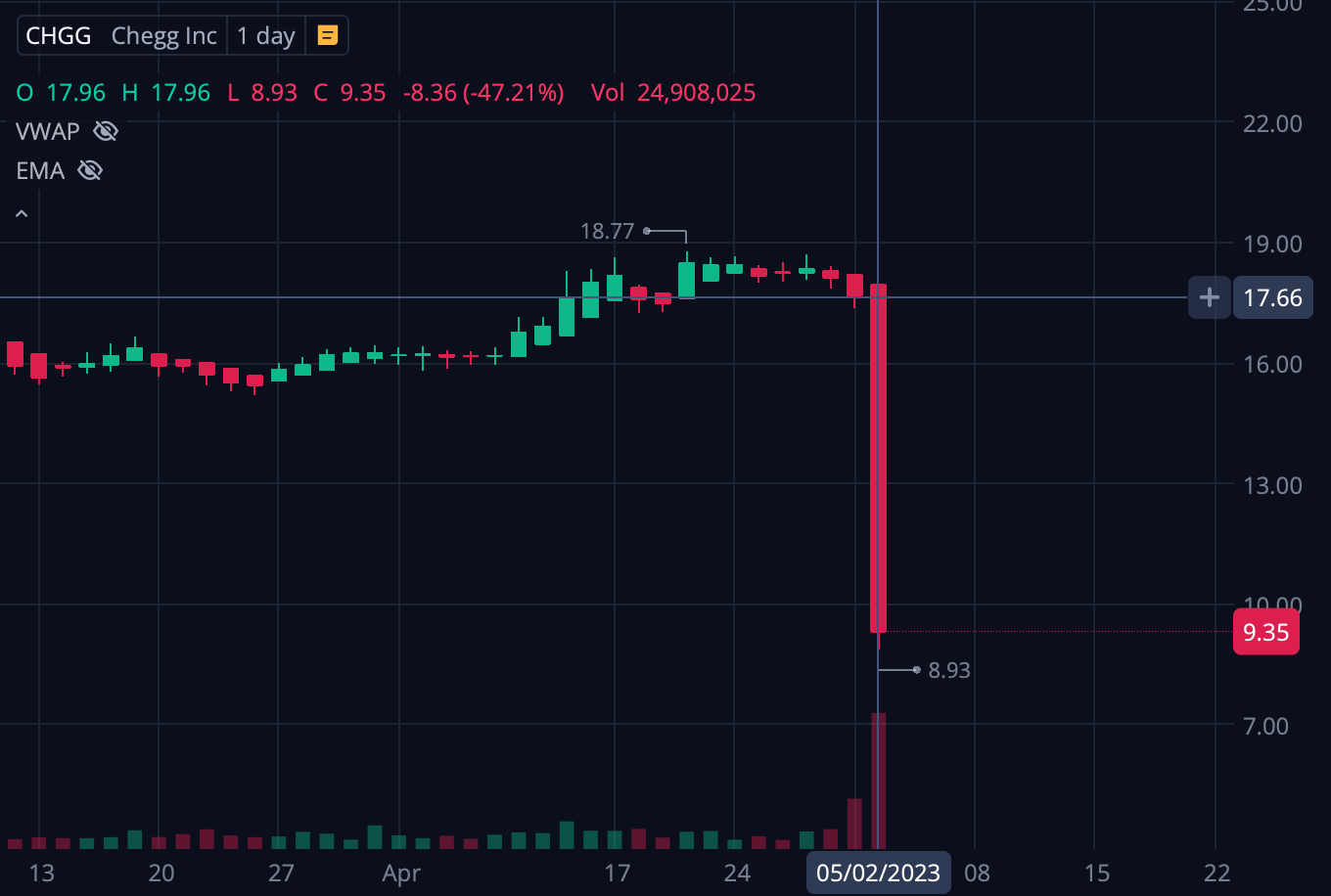
What student would give $15.95 to Chegg when they can give $20 to OpenAI to access GPT-4, which can do a million of other things, and which is about to become 10x more capable thanks to the plug-in system, the 32k token context window, and the new code interpreter model? (If you don’t know what I’m talking about, don’t worry. We’ll explain all these things in due course)
As more companies will start reporting how AI is impacting their revenues, there might be a rush to restructure the workforce to stay afloat and try to react.
A question worth asking, if you didn’t already: is your company business threatened by generative AI? If yes, is your company working to understand, master, and leverage generative AI to remain competitive?
I would ask that at the next company meeting because that strategy (or lack thereof) is going to impact all employees as we are seeing in this newsletter.
–
Reason #4: The CEO of TurnItIn says that thanks to AI, in 18 months, he will only need 20% of the few hundred engineers he’s employing now. And that he’ll hire them from high school. And probably the same will happen for sales and marketing.
TurnItIn is a software company that develops anti-plagiarism technology (in the currently-futile attempt to spot the use of ChatGPT). The CEO, Chris Caren, participated in a panel titled The Future of Integrity In The Brave New World of AI/GPT part of the prestigious ASU+GSV Summit, hosted by the Arizona State University and Global Silicon Valley Ventures.
You can watch Caren say that from min 21:50:
Now. Imagine you are one of his employees. And you find out that you have an 18 months time bomb on your head from YouTube.
Isn’t.that.exciting?
Come.on.
Who.wouldn’t.want.to.live.a.life.as.adventurous.as.that?
I’m sure that employees’ loyalty to this company is one of the highest in the United States. But it doesn’t matter because it sounds like Caren would happily hire monkeys to do the job if they could learn how to use ChatGPT.
If this kind of mindset spreads across startups, and it will if proven successful, even the job that today is considered one of the safest, the software engineer, starts to become a risky business.
–
Reason #5: Yuval Noah Harari just gave an interview to The Telegraph and told to Harry de Quetteville:
“Another danger is that a lot of people might find themselves completely out of a job, not just temporarily, but lacking the basic skills for the future job market. We might reach a point where the economic system sees millions of people as completely useless. This has terrible psychological and political ramifications.”
As you surely know, Harari is an Israeli historian and intellectual who wrote Sapiens and Homo Deus (which I cannot recommend enough). The former was originally published in 2011, and the latter in 2015.
The scholar got heavily criticized for painting doomsday scenarios. And maybe the criticism is justified. But then you are here, reading that a startup CEO is planning to fire 80% of his workforce in one year and a half and replace the remaining 20% with high-school students.
So, I don’t know. Maybe, let’s pay more attention with a healthy dose of scepticism?
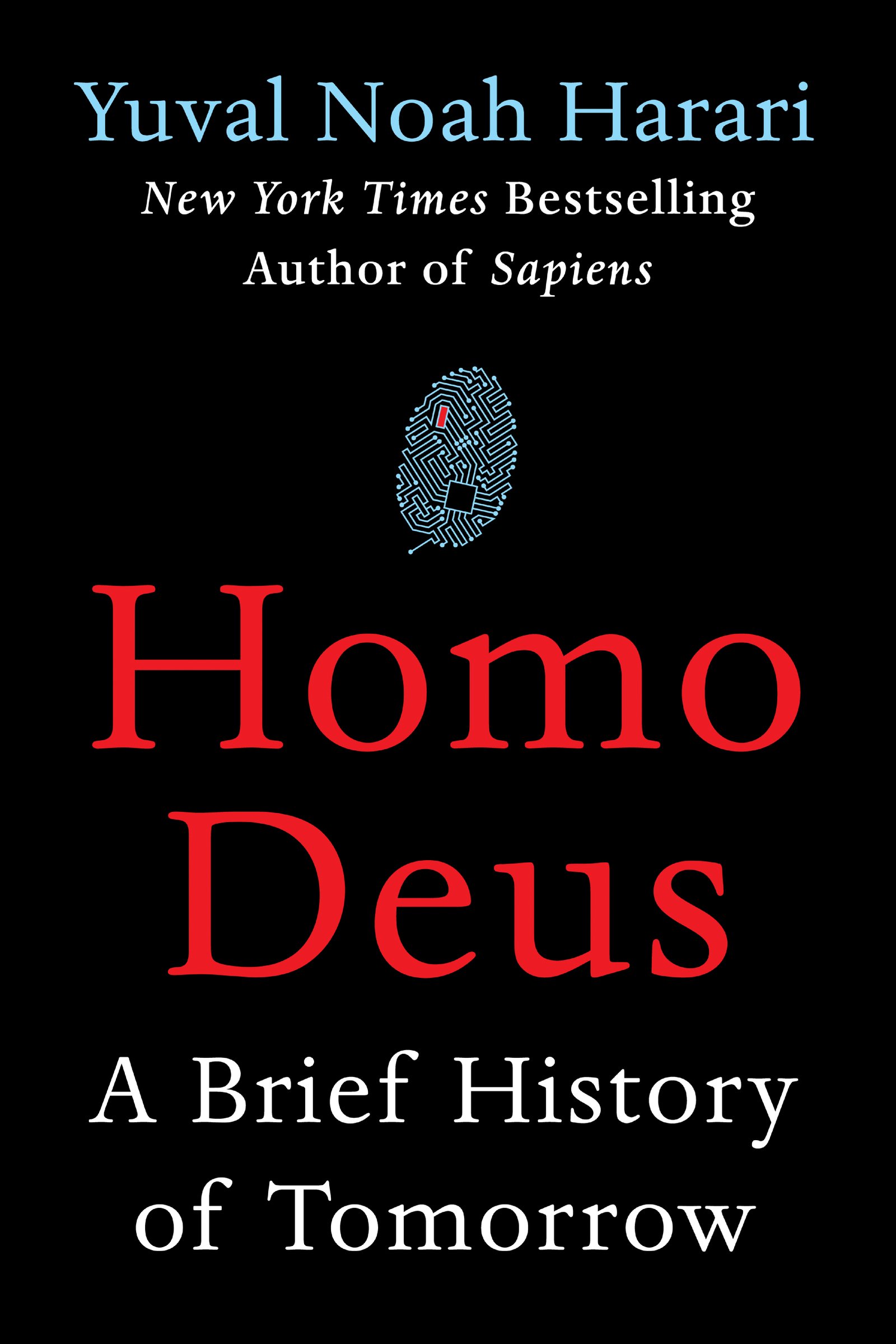
–
Reason #6: The godfather of artificial intelligence, Geoffrey Hinton, resigned from a post at Google he held for more than a decade so that he could openly talk about the risks of AI without damaging the company.
Cade Metz, reporting for The New York Times:
His immediate concern is that the internet will be flooded with false photos, videos and text, and the average person will “not be able to know what is true anymore.”
He is also worried that A.I. technologies will in time upend the job market. Today, chatbots like ChatGPT tend to complement human workers, but they could replace paralegals, personal assistants, translators and others who handle rote tasks. “It takes away the drudge work,” he said. “It might take away more than that.”
Like Harari, Hinton is one of the 1,000 AI experts that signed the Future of Life Institute (FLI) Open Letter to pause the development of extra-large language models. Which means bigger than GPT-4, with over 1 trillion parameters (if you don’t know what it means, don’t worry. It’s really not important).
As readers that follow this newsletter since the beginning, I am one of the first 100 people that signed that letter. Synthetic Work is meant as a research vehicle to understand if (and it’s a big if) our collective fears are justified and as an educational vehicle in case they are.
I try my best to provide an unbiased view of how the impact of AI on the job market and human labour is both positive and negative. And in the last 20 issues (10 for each Edition) we have reviewed together life-changing applications.
But during weeks like this, you have to be sure that the optimism for the short-term results doesn’t blindside you about the long-term outcomes.
Nutella is delicious until it makes you sick. And there’s no gradual transition from happy to miserable.

You won’t believe that people would fall for it, but they do. Boy, they do.
So this is a section dedicated to making me popular.
Reason #7 (you didn’t expect this, did you?):
The Journal of the American Medical Association (JAMA) published a new research clearly titled Comparing Physician and Artificial Intelligence Chatbot Responses to Patient Questions Posted to a Public Social Media Forum.
Guess which doctor the patients preferred?
That’s right:
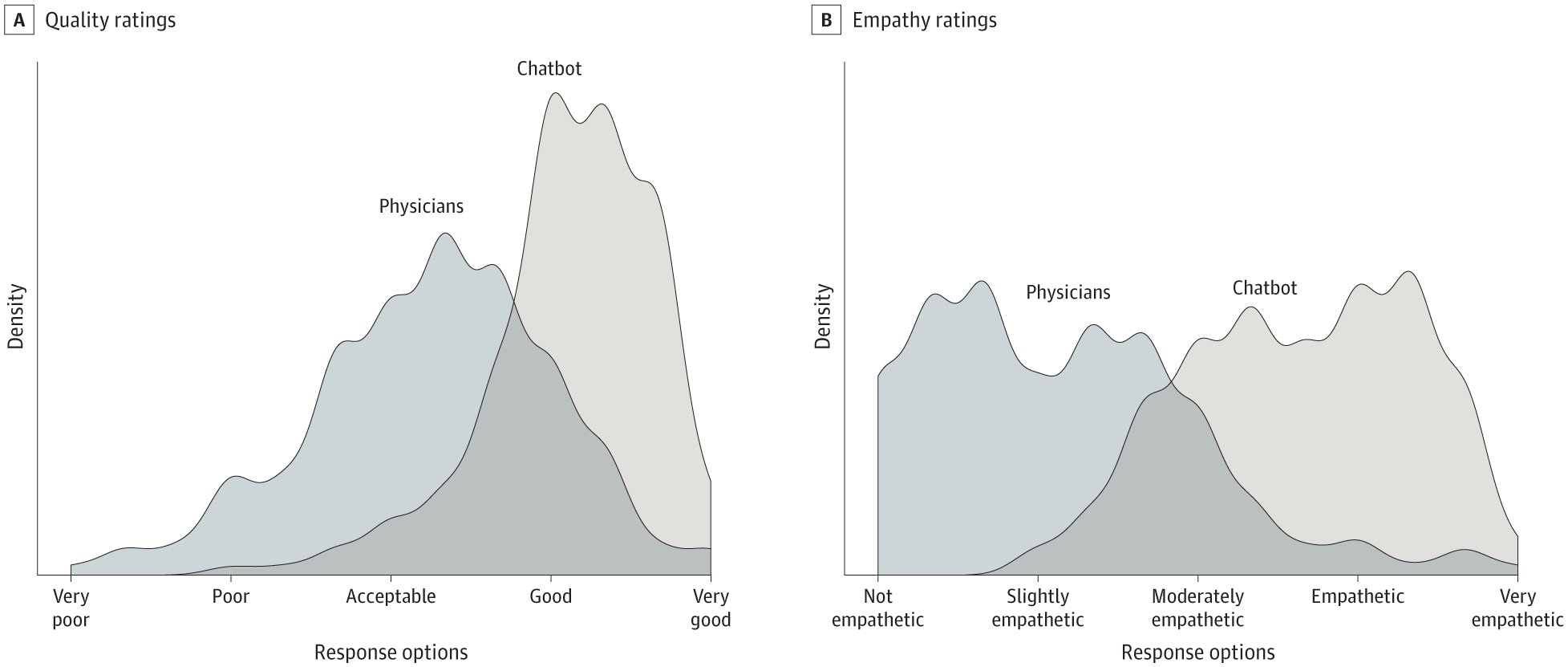
From the paper:
In this cross-sectional study of 195 randomly drawn patient questions from a social media forum, a team of licensed health care professionals compared physician’s and chatbot’s responses to patient’s questions asked publicly on a public social media forum. The chatbot responses were preferred over physician responses and rated significantly higher for both quality and empathy.
The chatbot in question is ChatGPT (not even GPT-4).
How did they do the study?
Studying patient questions from health care systems using a chatbot was not possible in this cross-sectional study because, at the time, the AI was not compliant with the Health Insurance Portability and Accountability Act of 1996 (HIPAA) regulations. Deidentifying patient messages by removing unique information to make them HIPAA compliant could change the content enough to alter patient questions and affect the chatbot responses. Additionally, open science requires public data to enable research to build on and critique prior research. Lastly, media reports suggest that physicians are already integrating chatbots into their practices without evidence. For reasons of need, practicality, and to empower the development of a rapidly available and sharable database of patient questions, we collected public and patient questions and physician responses posted to an online social media forum, Reddit’s r/AskDocs.
The online forum, r/AskDocs, is a subreddit with approximately 474 000 members where users can post medical questions and verified health care professional volunteers submit answers. While anyone can respond to a question, subreddit moderators verify health care professionals’ credentials and responses display the respondent’s level of credential next to their response (eg, physician) and flag a question when it has already been answered.
…
The original question, physician response, and chatbot response were reviewed by 3 members a team of licensed health care professionals working in pediatrics, geriatrics, internal medicine, oncology, infectious disease, and preventive medicine (J.B.K., D.J.F., A.M.G., M.H., D.M.S.). The evaluators were shown the entire patient’s question, the physician’s response, and chatbot response.
Brett Winton, Chief Futurist at ARK Invest, adds a valuable data point to the conversation:
“You’re suggesting that AI will replace my family doctor. What an outrage!”
In the pretend world where your family doctor would actually respond to a text, the labor-cost would be 11,000x higher than the cost to query chatGPT
With worse quality, answers more brusquely delivered https://t.co/dv5ExIj8CX pic.twitter.com/XnREcjUTHa
— Brett Winton (@wintonARK) May 2, 2023
This will only accelerate the growing adoption of AI in the Health Care industry we reviewed in Issue #4 – Medical AI to open new hospital in the metaverse to assist (human) ex doctors affected by severe depression.
And now, for the psychological side of things.
When I was a kid, I had to deal with a lot of grumpy and scary doctors. I hated that their manners and attitude added to the stress of the medical procedures that I was going through.
If an AI can be as competent as a doctor and, at the same time, can pose as a fun or engaging character, who do you think kids will prefer to be visited by? A human or GPT-4?
Those kids will eventually become adults, and their attitude towards AI will be dramatically different than what it is today.
While we all wait to be blessed by OpenAI and be granted access to the version of GPT-4 that can navigate the web, some of us can bear to use Microsoft Edge and its psychopathic Bing AI.
Bing AI is a version of GPT-4 with the capability to “see” what’s happening in the browser, use the browser to find answers to questions that it can’t answer out-of-the-box, and spam the aforementioned answers with ads.
Those of us able to endure both can reach the next level in pretending to be who they are not, asking the AI to suggest what to say next in an online conversation.
Ethan Mollick, a prolific professor at Wharton, shows us how:
"Give me something I can reply that will add to the conversation"
A future of weirdly nice reply bots? pic.twitter.com/vRLgXhMLRp
— Ethan Mollick (@emollick) April 26, 2023
At some point soon, it will start to be more convenient to be online all the time as it will be the only way to look good with the help of GPT-4 and successors. Yes, we’ll be able to use these large language models on our phones soon, but people will see us doing that. No good.
Online, nobody sees the recommendations we constantly get to appear like decent human beings.
And that’s how, ladies and gentlemen, that the metaverse will finally take off.
[music]
Join the Metaverse – Help us permanently and definitely hide the inadequacy of our species.
In the Education industry, the online education platform Khan Academy has partnered with OpenAI to create an AI tutor for students and an AI assistant for teachers.
We knew this since the OpenAI announcement of GPT-4, but now, in this new TED Talk, Khan Academy’s CEO shows how GPT-4 is now powering their new tool Khanmigo:
Two things to notice here:
- There is a huge amount of prompt massaging going on. Not just in controlling the kind of output that GPT-4 generates, but also in setting up a personality for the AI and a certain type of approach in offering the answers.The used prompting techniques are clearly different for the AI tutor version and for the AI teaching assistant version. Many of those techniques you find in the new How to Prompt section of Synthetic Work.
- When you watch this video, you realize how the addition of a synthetic voice would have a gigantic impact on our interactions with the AI. And how it seems inevitable that OpenAI’s next models will have to include synthetic voice generation.If you want a glimpse of how synthetic voices able to express emotions are a game changer, you just need to listen to my work-in-progress Fake Show.
…
